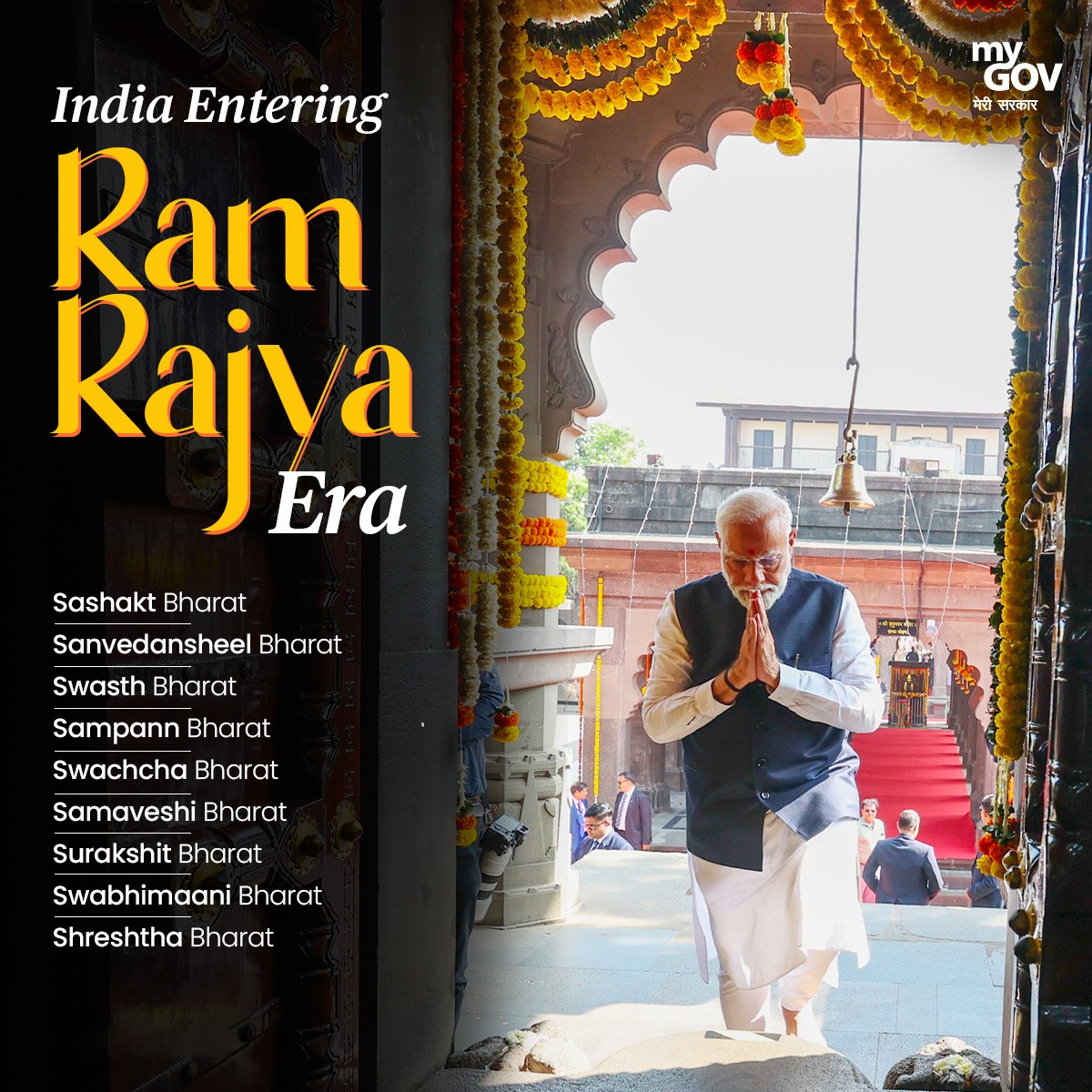In recent times, there has been a growing sentiment and discussion about India entering the era of Ram Rajya. The term “Ram Rajya” translates to the rule of Lord Rama, a revered figure in Hindu mythology, and symbolizes a state of ideal governance, justice, and prosperity. In this article, we explore the evolving narrative and aspirations surrounding the concept of Ram Rajya in the context of contemporary India.

Defining Ram Rajya:
The idea of Ram Rajya has deep roots in Indian cultural and religious traditions. It is often portrayed as a utopian state governed by principles of dharma (righteousness), justice, and ethical conduct. Lord Rama, the seventh avatar of Lord Vishnu, is considered the epitome of virtue and is revered for his commitment to truth and justice.
The Modern Interpretation:
In contemporary discussions, the concept of Ram Rajya is not confined to religious interpretations alone. Many see it as a metaphorical representation of an ideal society marked by good governance, social harmony, and economic prosperity. The vision is to build a nation where justice prevails, citizens coexist peacefully, and development is inclusive.
Elements of Ram Rajya in Today’s India:
- Social Harmony: The vision of Ram Rajya envisions a society free from discrimination and strife. In today’s India, efforts are being made to promote social harmony, unity in diversity, and inclusivity across various communities.
- Governance and Justice: The concept emphasizes just governance, where leaders are dedicated to the welfare of their citizens. Initiatives such as transparent governance, digital empowerment, and anti-corruption drives align with the principles associated with Ram Rajya.
- Economic Prosperity: Ram Rajya envisions economic prosperity for all. India’s economic development initiatives, including Make in India and Digital India, aim to create opportunities, reduce poverty, and elevate the standard of living for all citizens.
- Environmental Stewardship: Lord Rama is often portrayed as a protector of nature. In the context of Ram Rajya, there is a growing awareness of the need for sustainable development and environmental conservation in today’s India.
Challenges and Criticisms:
While the vision of Ram Rajya is aspirational, it is not without its challenges and criticisms. Critics argue that the term can be politically charged and may not be inclusive of the diverse religious and cultural fabric of India. Additionally, the practical implementation of the ideals associated with Ram Rajya requires careful consideration and comprehensive policies.
Moving Forward:
As India navigates its path toward progress, the concept of Ram Rajya serves as a guiding principle for many who aspire to see the nation achieve its fullest potential. The journey involves addressing societal challenges, embracing diversity, and ensuring that governance is just, transparent, and accountable.
About Slogan:
In recent years, India has set forth a comprehensive vision encompassing multiple facets of development and progress. Expressed through the slogan “Sashakt Bharat, Sanvedansheel Bharat, Swasth Bharat, Sampann Bharat, Swachh Bharat, Samaveshi Bharat, Surakshit Bharat, Swabhimani Bharat, Shreshtha Bharat,” this multifaceted vision reflects the country’s aspirations for holistic growth and inclusive development. In this article, we’ll explore each element of this vision and understand the collective ambition it represents.
1. Sashakt Bharat (Empowered India):
“Sashakt Bharat” embodies the idea of empowerment at various levels—individual, societal, and economic. The vision includes initiatives that empower citizens through education, skill development, and economic opportunities, fostering a self-reliant and confident nation.
2. Sanvedansheel Bharat (Sensitized India):
“Sanvedansheel Bharat” highlights the importance of empathy and awareness. It envisions a society where citizens are conscious of each other’s needs, challenges, and rights, fostering a culture of understanding, compassion, and social responsibility.
3. Swasth Bharat (Healthy India):
“Swasth Bharat” emphasizes the significance of health and well-being. The vision includes initiatives for accessible healthcare, preventive measures, and awareness programs to ensure a healthier population and a robust healthcare infrastructure.
4. Sampann Bharat (Prosperous India):
“Sampann Bharat” envisions economic prosperity for all. It involves policies and strategies aimed at inclusive economic growth, poverty alleviation, and creating opportunities that benefit every stratum of society.
5. Swachh Bharat (Clean India):
“Swachh Bharat” has been a flagship initiative focused on cleanliness and sanitation. It strives to create a cleaner environment, emphasizing the importance of hygiene, waste management, and maintaining cleanliness in public spaces.
6. Samaveshi Bharat (Inclusive India):
“Samaveshi Bharat” underscores the significance of inclusivity and diversity. This vision promotes equal opportunities and social harmony, ensuring that every citizen, regardless of background, has an equal stake in the nation’s progress.
7. Surakshit Bharat (Safe India):
“Surakshit Bharat” prioritizes the safety and security of citizens. This includes initiatives for public safety, disaster preparedness, and the creation of a secure environment, fostering trust and a sense of security among the population.
8. Swabhiman Bharat (Proud India):
“Swabhiman Bharat” focuses on instilling pride and a sense of belonging among the citizens. It involves celebrating the rich cultural heritage of India, promoting national identity, and fostering a sense of pride in being Indian.
9. Shreshtha Bharat (Best India):
“Shreshtha Bharat” encapsulates the aspiration for excellence in various domains. It calls for continuous improvement in education, innovation, governance, and every aspect that contributes to making India the best version of itself.
Conclusion:
India’s entry into the era of Ram Rajya is a vision that resonates with ideals of justice, harmony, and prosperity. While the concept draws inspiration from religious narratives, its modern interpretation calls for inclusive development, good governance, and social cohesion. As India strives for progress, the principles associated with Ram Rajya can serve as a compass guiding the nation toward a future characterized by righteousness, unity, and shared prosperity.


